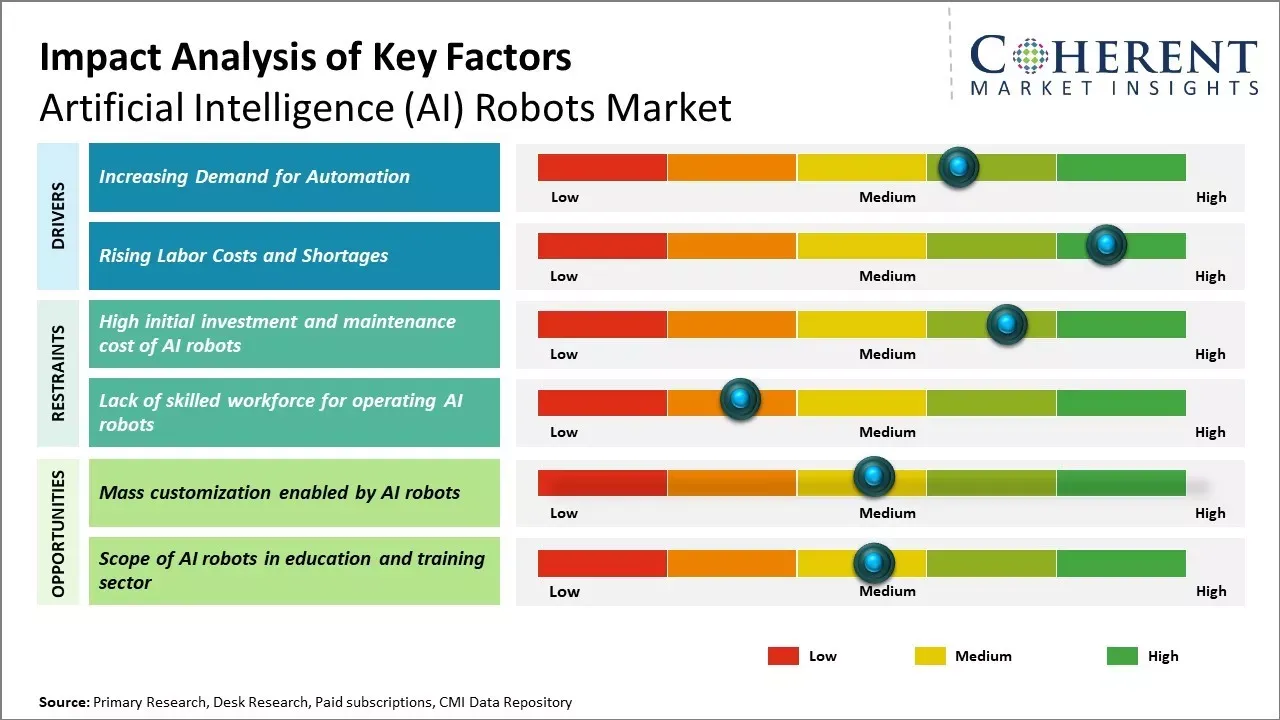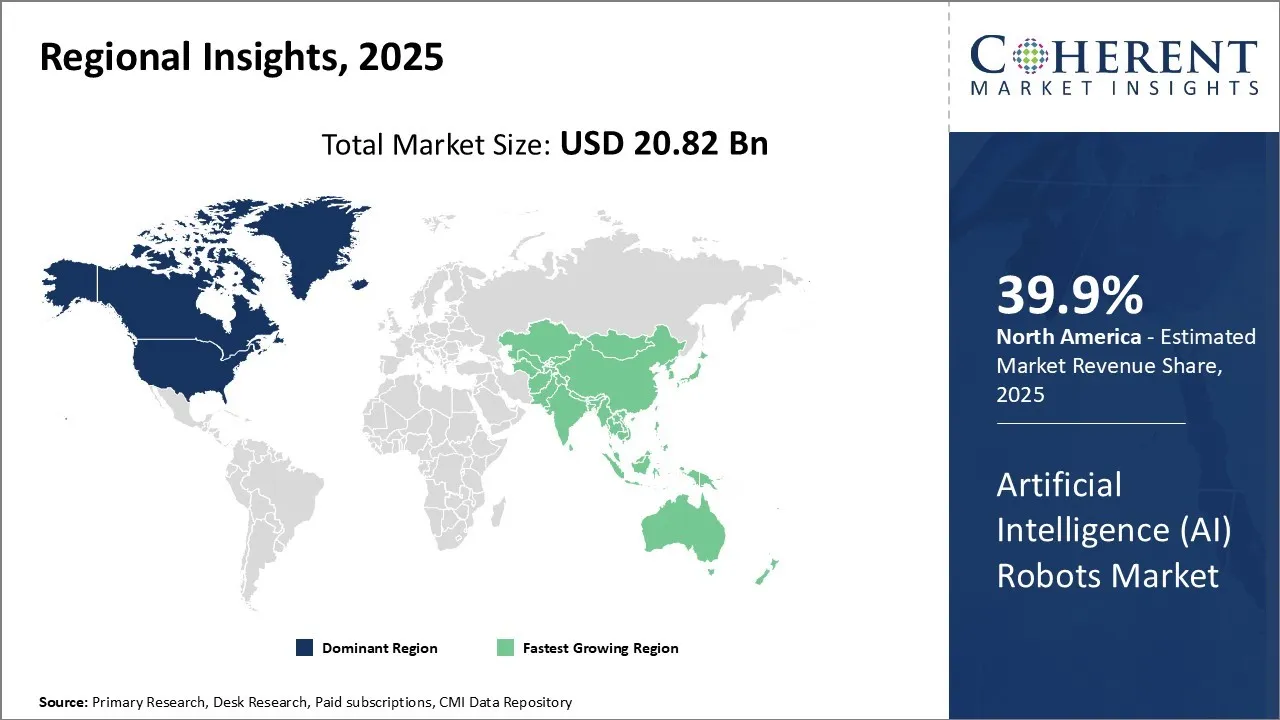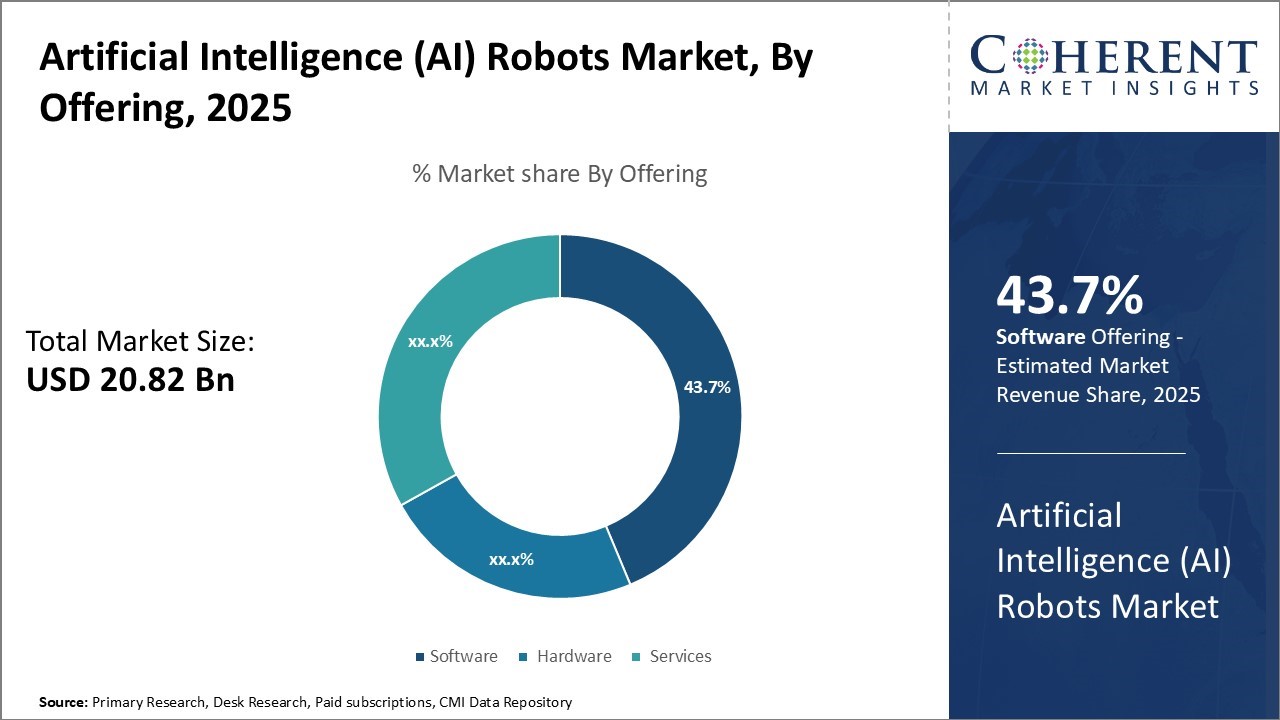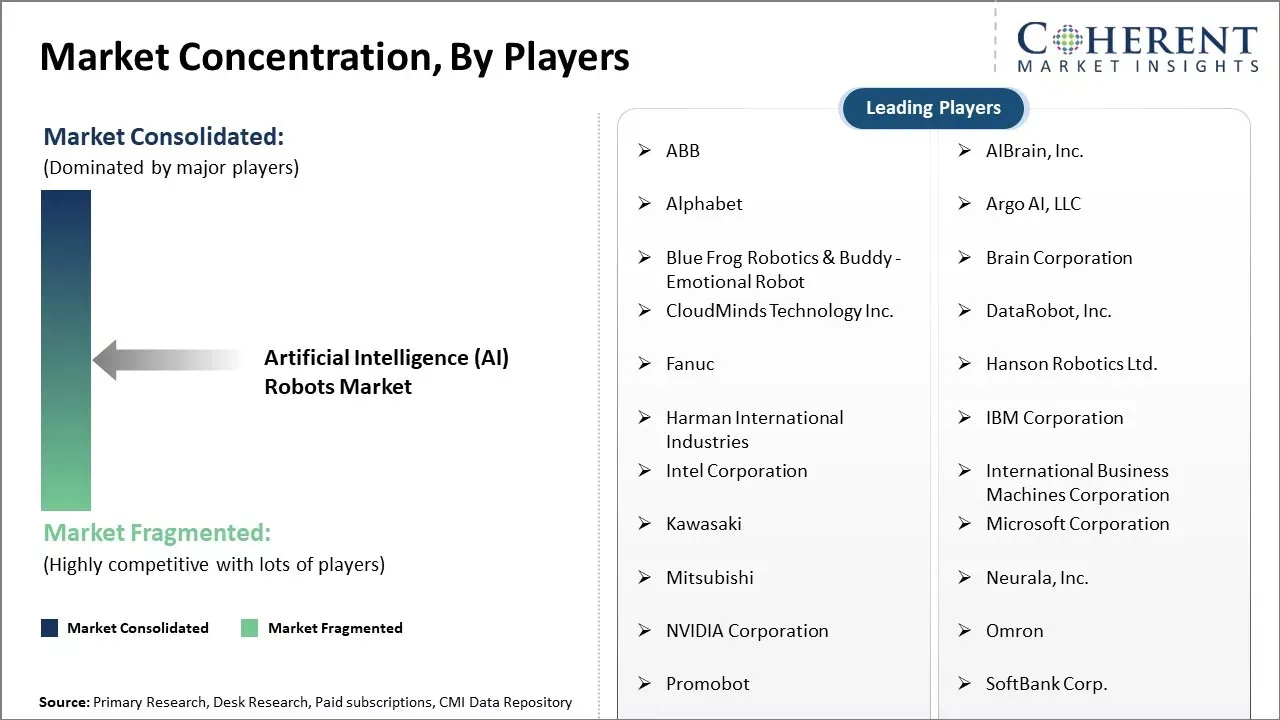Artificial Intelligence (AI) Robots Market Size and Trends
The Artificial Intelligence (AI) robots market is estimated to be valued at USD 20.82 Bn in 2025 and is expected to reach USD 149.34 Bn by 2032, growing at a compound annual growth rate (CAGR) of 32.5% from 2025 to 2032.

To learn more about this report, Download Free Sample
Key Takeaways
- Based on Offering, the Software segment is expected to hold 43. 7% artificial intelligence (AI) robots market share in 2025, driven by its flexibility and customization capabilities.
- Based on Robot Type, the Industrial robot segment is projected to account for 43% of the market share in 2025, fueled by the widespread use in automating manufacturing processes.
- Based on Technology, Context Awareness segment leads the market holding an estimated share of 36. 9% in 2025, owing to its potential for allowing more human-like interaction.
- Based on Deployment Mode, the Cloud segment is expected to hold the highest share in the market in 2025, owing to its scalability and flexibility.
- Based on Region, North America is projected to lead the global artificial intelligence (AI) robots market in 2025 with a 39. 9% due to strong presence of major technology technology giants and robotics companies. While, Asia Pacific is considered to be the fastest growing region during the forecast period.
Market Overview
The widespread industrial applications of AI robots in the automotive, manufacturing, healthcare, and other sectors are supporting the rapid AI robots market growth. The Artificial Intelligence (AI) Robots Market trend shows a growing demand for collaborative and service robots that can operate safely alongside human beings. Advanced technologies like machine learning, computer vision, and adaptive learning are enabling the development of more sophisticated AI robots that can perform complex tasks autonomously. Integration of 5G infrastructure allows for cloud-based AI and over-the-air software upgrades. This momentum, coupled with a global push for automation, is a key driver of artificial intelligence (AI) robots market growth across various verticals.
Current Events and Its Impact
|
Current Event |
Description and its Impact |
|
Geopolitical Tensions Affecting Semiconductor Supply Chains |
|
|
Regulatory Shifts in AI Governance |
|
Uncover macros and micros vetted on 75+ parameters: Get instant access to report
Pricing Analysis of AI Robots
- Factors Influencing Pricing:
- Type & Complexity: Industrial robots, service robots, and consumer AI robots differ widely in cost based on capabilities.
- Hardware Components: Sensors, actuators, processors, and durability materials affect price.
- Software & AI Capabilities: Advanced AI algorithms, machine learning models, and integration features raise costs.
- Customization: Tailored solutions for specific industries or tasks increase price.
- Scale & Volume: Bulk orders generally reduce per-unit costs.
- Maintenance & Support: Ongoing updates, support contracts, and warranties add to total cost of ownership.
- Price Ranges by Category:
- Consumer Robots (e.g., robotic vacuums, personal assistants): $200 - $2,000
- Service Robots (e.g., healthcare, retail): $10,000 - $100,000
- Industrial Robots (e.g., manufacturing, logistics): $50,000 - $500,000+
- Specialized AI Robots (e.g., autonomous vehicles, drones): $100,000 - several million dollars
Artificial Intelligence (AI) Robots Market Insights, By Offering - Software Enables Flexibility and Customization in AI Solutions
In terms of offering, software segment contributes the highest share of the market owning 43.7% in 2025 to its flexibility and customization capabilities. Software solutions allow AI systems to be tailored specifically to the unique needs and processes of each customer. Robotic software can be programmed and re-programmed to perform a wide variety of tasks simply by editing code, without the need to physically alter any hardware. This delivers significant cost savings compared to hardware-centric alternatives, as the same software can potentially be deployed across multiple robot models and use cases.
Software also enables continuous improvements and innovation over the lifespan of a robot. As new algorithms are developed, patches or upgrades can push changes to fleets of robots instantly through software updates. This helps businesses quickly take advantage of the latest AI innovations without replacing existing equipment. The modular nature of software also makes integration into existing IT systems straightforward. Robots running standardized operating systems can easily share data and coordinate tasks with other tools on the factory floor or in other operational settings.
In May 2025, Chaina advanced its robotics software with operating system to support domestic chips, through the Intewell operating systems, which has launched by Beijing-based Kyland Technology. It is designed to serve as a foundational software system for embodied intelligence robots. The launch of the system aligns with Beijing’s broader push for self-sufficiency in strategic technologies such as artificial intelligence (AI) and robotics amid rising geopolitical tensions and export restrictions from the US.
Artificial Intelligence (AI) Robots Market Insights, By Robot Type - Industrial Robots Enable Increased Automation and Productivity Gains
In terms of robot type, industrial robots segment contributes the highest share owing 43% in 2025 due to their widespread use in automating manufacturing processes. Industrial robots are specially designed to perform repetitive, hazardous, or labor-intensive tasks with high precision and reliability in production environments. Their deployment leads to significant gains in productivity by reducing labor costs and allowing 24/7 operations.
One key factor driving increased industrial robot adoption is the ongoing labor shortage facing many industries. As population ages and birth rates decline in developed nations, there simply may not be enough people to fill all open manufacturing jobs in the future. AI robots can help alleviate this problem by taking over dull, dirty, and dangerous jobs that humans often do not want to perform.
In April 2025, at Automate 2025 in Detroit, Universal Robots (UR) and Mobile Industrial Robots (MiR), both under Teradyne Robotics, showcased advanced AI-driven automation solutions across automotive, electronics, and logistics sectors. Highlights included UR's AI Accelerator toolkit, developed with NVIDIA, enhancing cobot capabilities in tasks like painting and quality inspection.
Artificial Intelligence (AI) Robots Market Insights, By Technology - Context Awareness Unlocks New Applications for AI Systems
In terms of technology, context awareness contributes the highest share owing 36.9% in 2025 due to its potential for allowing more human-like interaction. Context awareness refers to the ability of AI systems to understand and make decisions based on the situation or environment surrounding user interactions. This involves perceiving relevant sensory data to determine factors such as the physical location, identities of nearby people, the current task being performed, and others.
Context awareness also enhances traditional robotic uses. For industrial robots, understanding the factory context enables safer human-robot collaboration. In service robotics, context allows reading patient emotions or discerning household activity to offer assistance proactively. Even software could vary output based on devices used or time of day for maximum relevance. By incorporating unstructured contextual dimensions, AI may begin to solve problems as creatively as humans do in similar situations.
In January 2025, Contextual AI Inc. launched its flagship Contextual AI Platform, now generally available. This platform enables enterprises to build specialized retrieval-augmented generation (RAG) agents that automate knowledge work.
Artificial Intelligence (AI) Robots Market Insights, By Deployment Mode - Cloud Allows Scalability and Flexibility
In term of deployment code, the cloud segment is projected to contribute the highest share of the market in 2025, largely due to its ability to offer companies with scale resourced up or down instantly, which is critical for AI and automation workloads. Cloud based deployment has no need for heavy upfront investments in hardware o infrastructure resulting in lower initial cost. It is also the fastest mode of deployment enabling quicker implementation and global access, speeding up innovation and rollouts. Cloud platforms offer built-in tools for analytics, AI, and IoT, which are crucial for industries embracing automation. Modern cloud providers offer advanced, compliant security features, addressing one of the earlier barriers to adoption.
In May 2025, GMO Internet, Inc. announced that its high-performance computing platform, "GMO GPU Cloud," has been officially adopted by the AI Robot Association (AIRoA) as the next-generation robot development platform. GMO GPU Cloud offers Japan's fastest commercial GPU processing capabilities, integrating high-capacity data storage, high-speed networking, and robust security infrastructure. This collaboration aims to accelerate technological innovation and real-world implementation in Japan's robotics industry.
Regional Insights

To learn more about this report, Download Free Sample
North America Artificial Intelligence (AI) Robots Market Analysis & Trends
North America has established itself as the dominant region showcasing Artificial Intelligence (AI) Robots Market demand owing 39.9% in 2025. With a strong presence of major technology giants and robotics companies such as Google, Microsoft, Amazon, iRobot, and Boston Dynamics, the U.S. accounts for the largest share. Companies in the U.S. are at the forefront of developing innovative AI and robotics technologies for industrial as well as domestic applications. Heavy investments in R&D by both private players as well as defense organizations have created a conducive environment for advances. The presence of a large consumer market combined with high disposable incomes also make North America an attractive market for the deployment of domestic and consumer robots. Stringent quality and safety standards ensure reliability of robots developed for various applications.
In May 2025, Canadian Tire Corporation (CTC) launched two tech innovations: CeeTee, a shopping assistant in the Canadian Tire app’s “Tires” section to help customers choose the right tires, and a partnership with Sanctuary AI to introduce human-like “General Purpose Robots” aimed at handling repetitive tasks in stores and distribution centers, allowing employees to focus on higher-value work.
Asia Pacific Artificial Intelligence (AI) Robots Market Analysis and Trends
The Asia Pacific region has emerged as the fastest growing market for AI robots globally in recent times. Countries like China, Japan, South Korea, and India have shown tremendous commitment towards development and adoption of robots. Rapid industrialization and rising labor costs have boosted the use of robots across Japanese and Korean factories for improved productivity and reduced labor requirements. In China, strong government support through Made in China 2025 initiative has enabled significant growth, especially in industrial robot shipments. AI startups in China are making large investments in autonomy technologies and applications customized for local needs such as elderly care, surveillance, and logistics. For instance, in May 2025, China advanced the deployment of AI-powered humanoid robots to transform its manufacturing sector, addressing challenges such as labor shortages and economic pressures. Startups like AgiBot and MagicLab, supported by substantial government funding exceeding $20 billion, are developing robots capable of complex tasks like assembly and quality control. The massive consumer market also offers huge opportunities for deployment of service robots across sectors in the coming years.
Artificial Intelligence (AI) Robots Market Outlook Country-wise
The United States Artificial Intelligence (AI) Robots Market Trends
The U.S. artificial intelligence (AI) robot market is characterized by strong demand in industrial automation, healthcare, and defense sector. The United States has a shortage of labor in manufacturing, logistics, and healthcare staff which is pushing industries to adoption AI-powered robots. As of 2025, US labor shortage currently sits at 70%, five percentage points below the global average. Aging workforce is also accelerating automation, Today, about 19% of people 65 and older in the US are still working, up from 10% four decades ago. This further propels the demand for AI robots.
Saudi Arabia Artificial Intelligence (AI) Robots Market Trends
Saudi Arabia artificial intelligence (AI) robots market is experiencing rapid growth, fueled by government initiatives, promoting AI adoption, increasing demand for automation in various sectors. For instance, in May 2025 MILLIONS of pilgrims started congregating at the Holy Mosque in Makkah to perform the annual Haj. over 1.25 million international pilgrims have already arrived in Saudi Arabia. India’s quota for Haj in 2025 is 175,025. AI-driven robot is equipped to provide real-time religious guidance to pilgrims from diverse linguistic backgrounds. Supporting 11 languages, including Arabic, English, Urdu, Bengali, and Malay, it serves a wide array of the global Muslim community. These capabilities ensure that language barriers do not hinder the spiritual journey of pilgrims who travel from all corners of the world.
China Artificial Intelligence (AI) Robots Market Trends
China continues to be the leader in the artificial intelligence (AI) robots market, with rapid urbanization, infrastructure development and government support through the initiative such as “Made in China 2025” which has propelled AI robotics adoption in constructions, logistics and smart city projects. For Instance, in May 2025, China, Suzhou-based robotics startup JoyIn has raised over USD 13 million in an angel+ funding round, just three months after its initial angel investment. JoyIn specializes in developing AI-powered home-use robots. The new funding will accelerate the production and deployment of JoyIn's AI-driven robots, aiming to enhance daily life through advanced automation. This investment reflects growing confidence in China's consumer robotics sector and JoyIn's potential to become a leader in home AI solutions.
Recent Development
- In May 2025, Hugging Face expanded into robotics by introducing two open-source humanoid robots, Hugbot and LeRobot. These robots are designed to test AI models in real-world environments, bridging the gap between digital intelligence and physical interaction. The initiative aims to democratize robotics, making it more transparent and accessible to researchers and developers.
- In March 2025, Da Spatio Rhobotique Laboratory Pvt. Ltd (DSRL), a startup incubated at IIT Guwahati, developed autonomous robots designed for AI-driven surveillance at international borders. These robots offer real-time monitoring across challenging terrains, overcoming limitations of traditional security measures. The Defence Research and Development Organisation has acknowledged their potential for integration into India's defence infrastructure.
- In January 2025, Ambi Robotics launched PRIME-1, the first vertically integrated AI foundation model designed for warehouse robotics. Trained on over 20 million real-world images from 150,000 hours of robotic operations, PRIME-1 enhances 3D perception, package picking, and quality control. This model enables faster deployment and improved reliability of robotic solutions.
- In September 2024, Kawasaki Robotics introduced its latest innovation—the CL Series collaborative robots (cobots). This new launch is developed in partnership with NEURA Robotics, these industrial-grade cobots offer enhanced performance and safety features, including Zero Gravity (Zero G) mode for intuitive hand guidance and high-speed operation with ±0.02 mm repeatability. It is designed for tasks such as welding and machine tending. The company is committed to offering flexibility, and high-efficiency manufacturing.
Market Report Scope
Artificial Intelligence (AI) Robots Market Report Coverage
| Report Coverage | Details | ||
|---|---|---|---|
| Base Year: | 2024 | Market Size in 2025: | USD 20.82 Bn |
| Historical Data for: | 2020 To 2024 | Forecast Period: | 2025 To 2032 |
| Forecast Period 2025 to 2032 CAGR: | 32.5% | 2032 Value Projection: | USD 149.34 Bn |
| Geographies covered: |
|
||
| Segments covered: |
|
||
| Companies covered: |
ABB, AIBrain, Inc., Alphabet, Argo AI, LLC, Blue Frog Robotics & Buddy - Emotional Robot, Brain Corporation, CloudMinds Technology Inc., DataRobot, Inc., Fanuc, Hanson Robotics Ltd., Harman International Industries, IBM Corporation, Intel Corporation, International Business Machines Corporation, Kawasaki, Microsoft Corporation, Mitsubishi, Neurala, Inc., NVIDIA Corporation, Omron, Promobot, SoftBank Corp., UB Tech Robotics, Inc., Veo Robotics, Inc., Vicarious, Xilinx, and Yaskawa |
||
| Growth Drivers: |
|
||
| Restraints & Challenges: |
|
||
Uncover macros and micros vetted on 75+ parameters: Get instant access to report
Artificial Intelligence (AI) Robots Market Driver
Increasing Demand for Automation
Manual and repetitive jobs that require high accuracy are now being taken over by AI robots. This is helping companies improve productivity and efficiency while reducing costs at the same time. Machines can work tirelessly for hours without tiring or needing breaks, allowing 24/7 operations in factories and warehouses. Furthermore, AI capabilities are making robots more intelligent where they can seamlessly collaborate and co-exist with human workers.
The manufacturing industry has widely adopted robots for tasks like welding, painting, assembling, and product inspection. AI robots integrated with computer vision can detect defects with far greater accuracy than humans. This ensures improved quality of products as well as increased safety levels on the production floor. Supply chains and logistics is another major area benefiting from automated robots for material handling, packaging, palletization, and shipment sorting. E-commerce companies in particular rely heavily on robots to efficiently process a massive volume of orders throughout the year without seasonal disruptions. The food and beverage industry too are deploying smart robots for picking and packing orders, mixing ingredients as well as inspecting items coming off the production line.
Rising Labor Costs and Shortages
Another key factor spurring the adoption of AI robots is the steadily rising costs of human labor coupled with widespread shortages of workforce. With economic growth and improved standards of living, wages the world over have been increasing consistently in recent times. This is making labor intensive operations very expensive for companies. At the same, diminishing working population due to lower birth rates represents a significant challenge. Particularly in developed nations with aging demographics, recruiting and retaining employees is proving difficult. Globally, a significant percentage of businesses (ranging from 69% to 77% in recent years) report facing labor shortages. These labor dynamics are a central focus in artificial intelligence (AI) robots market research, highlighting automation as a strategic solution.
Artificial Intelligence (AI) Robots Market Opportunities
Mass customization enabled by AI robots
As technology advances, the artificial intelligence (Ai) robots market value is expected to rise significantly, driven by expanding applications and decreasing costs. Sectors like healthcare, logistics, and manufacturing are ripe for increased robotics adoption. An aging population will drive the demand for robotic assistants. Meanwhile, robots that can collaborate safely with humans opens new applications.
Market Segmentation
- By Offering
- Software
- Hardware
- Services
- By Robot Type
- Service Robots
- Industrial Robots
- Others
- By Technology
- Machine Learning
- Computer Vision
- Context Awareness
- Natural Language Processing
- By Deployment Mode
- Cloud
- On-premises
- By Regional
- North America
- U.S.
- Canada
- Latin America
- Brazil
- Argentina
- Mexico
- Rest of Latin America
- Europe
- Germany
- U.K.
- Spain
- France
- Italy
- Russia
- Rest of Europe
- Asia Pacific
- China
- India
- Japan
- Australia
- South Korea
- ASEAN
- Rest of Asia Pacific
- Middle East
- GCC Countries
- Israel
- Rest of Middle East
- Africa
- South Africa
- North Africa
- Central Africa
- North America
- Key Players
- ABB
- AIBrain, Inc.
- Alphabet
- Argo AI, LLC
- Blue Frog Robotics & Buddy - Emotional Robot
- Brain Corporation
- CloudMinds Technology Inc.
- DataRobot, Inc.
- Fanuc
- Hanson Robotics Ltd.
- Harman International Industries
- IBM Corporation
- Intel Corporation
- International Business Machines Corporation
- Kawasaki
- Microsoft Corporation
- Mitsubishi
- Neurala, Inc.
- NVIDIA Corporation
- Omron
- Promobot
- SoftBank Corp.
- UB Tech Robotics, Inc.
- Veo Robotics, Inc.
- Vicarious
- Xilinx
- Yaskawa
Sources
Primary Research Interviews from the following stakeholders
Stakeholders
- Interviews with AI robot manufacturers, industrial automation managers, systems integrators, R&D engineers, procurement heads, and digital transformation officers across major deployment sectors.
Specific stakeholders
- Automation heads at automotive plants (e.g., Ford, Hyundai, General Motors)
- Robotics engineers and innovation leads at electronics manufacturers (e.g., Foxconn, Panasonic, Bosch)
- CTOs and heads of AI strategy at logistics and warehousing firms (e.g., FedEx, DHL, Maersk)
- Plant managers at food & beverage companies using robotic automation (e.g., Nestlé, PepsiCo, Unilever)
- Procurement officers at public hospitals and medical centers using surgical and service robots
- Facilities and operations leads in smart factories and ports using collaborative robots (cobots)
- AI engineers and roboticists in universities and research labs (e.g., MIT CSAIL, IITs, ETH Zurich)
- Automation leads at defense and aerospace contractors implementing autonomous mobile robots
- Product managers and heads of AI at consumer electronics companies integrating AI bots into smart devices
Databases
- World Robotics Database (International Federation of Robotics)
- United Nations Industrial Development Organization (UNIDO) Statistics
- World Trade Organization (WTO) Trade Statistics
- U.S. Bureau of Economic Analysis (BEA)
- Eurostat (EU Statistics on AI/Automation)
- China Customs Statistics
- Japan Ministry of Economy, Trade and Industry (METI) – Industrial Robot Data
- Directorate General of Commercial Intelligence and Statistics (DGCIS), India
- Korea Statistical Information Service (KOSIS)
- Department of Science and Technology (DST), India
Magazines
- Robotics Business Review
- Industrial Robot: An International Journal
- IEEE Spectrum – Robotics and AI section
- Robotics & Automation News
- The Robot Report
- Embedded Computing Design – AI Robotics Features
- Automation World
- Control Engineering – Robotics Trends
- Electronic Design Magazine – AI & Edge Robotics Focus
Journals
- IEEE Transactions on Robotics
- Robotics and Autonomous Systems (Elsevier)
- Journal of Intelligent & Robotic Systems
- International Journal of Robotics Research
- Journal of Field Robotics
- ACM Transactions on Human-Robot Interaction
- Advanced Intelligent Systems
- Journal of Manufacturing Systems – Robotics Section
Newspapers
- The Wall Street Journal – Technology & Innovation
- The Economic Times – AI & Manufacturing
- The Hindu Business Line – Automation & Industrial Robotics
- Financial Times – Robotics Industry Insights
- Nikkei Asia – Robotics & Semiconductor Ecosystem
- South China Morning Post – AI, Robotics & Supply Chain
- The New York Times – Technology / AI Features
- Business Standard – Tech & Industry
Associations
- International Federation of Robotics (IFR)
- Robotics Industries Association (RIA)
- IEEE Robotics and Automation Society
- Japan Robot Association (JARA)
- Korea Association of Robot Industry (KAR)
- Confederation of Indian Industry (CII) – Advanced Manufacturing Cell
- EU Robotics (SPARC Program)
- National Robotics Initiative (NRI), USA
- Robotics Society of India (RSI)
Public Domain Sources
- U.S. National Institute of Standards and Technology (NIST) – Smart Manufacturing Reports
- European Commission – AI and Robotics Reports
- India Ministry of Electronics & Information Technology (MeitY)
- Ministry of Economy, Trade and Industry (METI), Japan
- Department of Science and Technology (DST), India
- U.S. International Trade Commission (USITC)
- NITI Aayog – AI for All Strategy
- EU Digital Single Market Observatory
- Reserve Bank of India (RBI) – Industry and Automation Trends
- India Investment Grid – Robotics and Smart Manufacturing Projects
Proprietary Elements
- CMI Data Analytics Tool, and Proprietary CMI Existing Repository of information for last 8 years
Share
Share
About Author
Ankur Rai is a Research Consultant with over 5 years of experience in handling consulting and syndicated reports across diverse sectors. He manages consulting and market research projects centered on go-to-market strategy, opportunity analysis, competitive landscape, and market size estimation and forecasting. He also advises clients on identifying and targeting absolute opportunities to penetrate untapped markets.
Missing comfort of reading report in your local language? Find your preferred language :
Transform your Strategy with Exclusive Trending Reports :
Frequently Asked Questions
EXISTING CLIENTELE
Joining thousands of companies around the world committed to making the Excellent Business Solutions.
View All Our Clients



